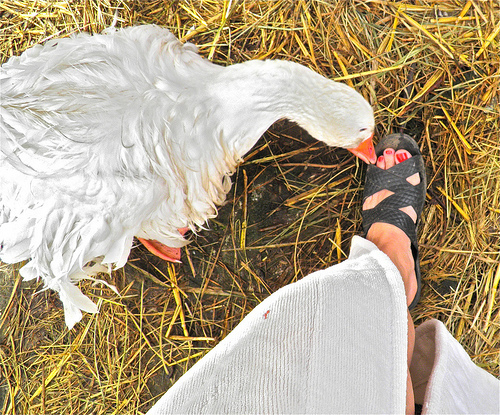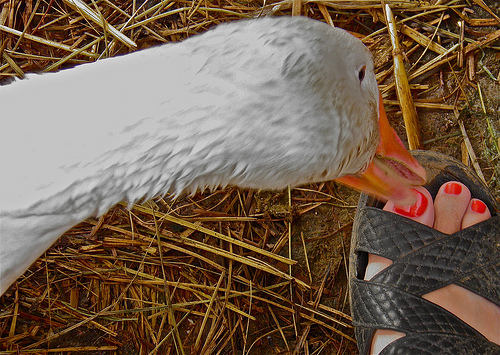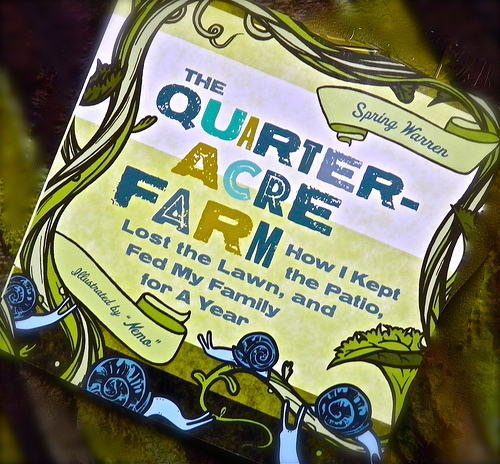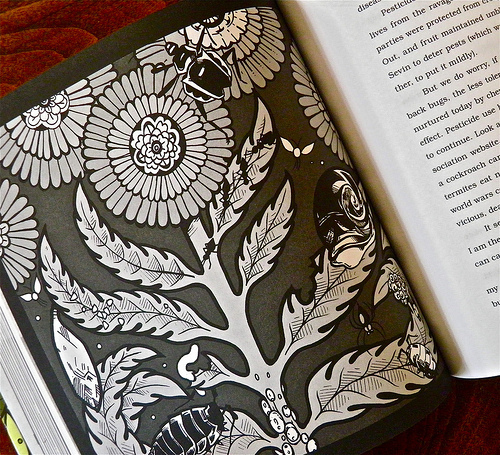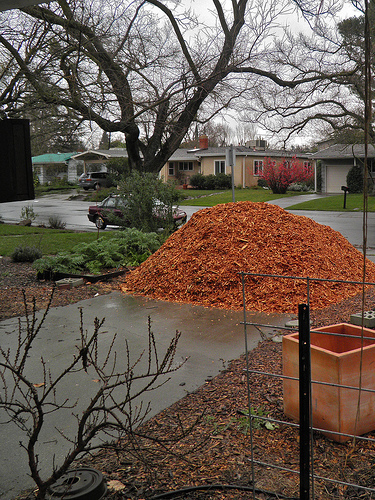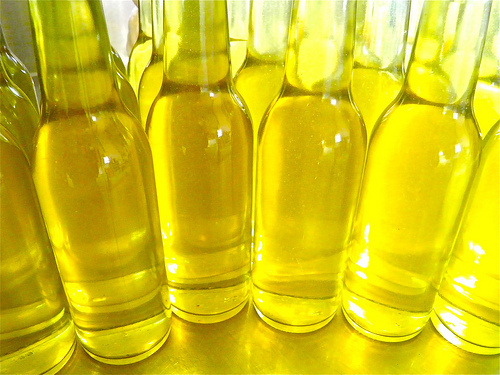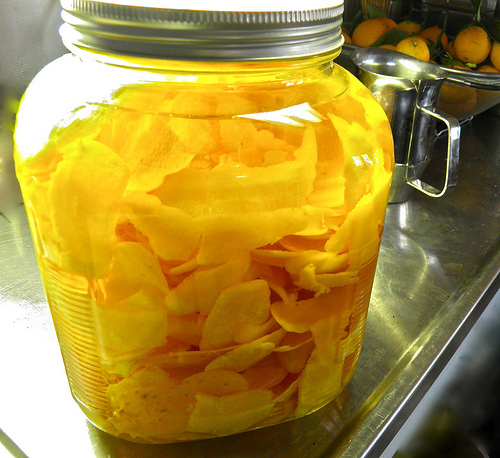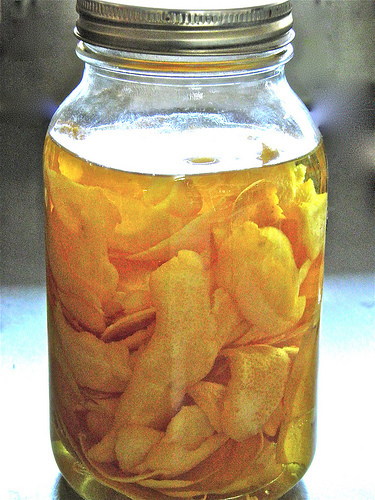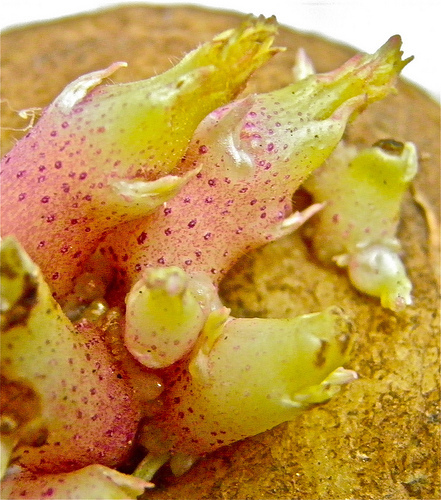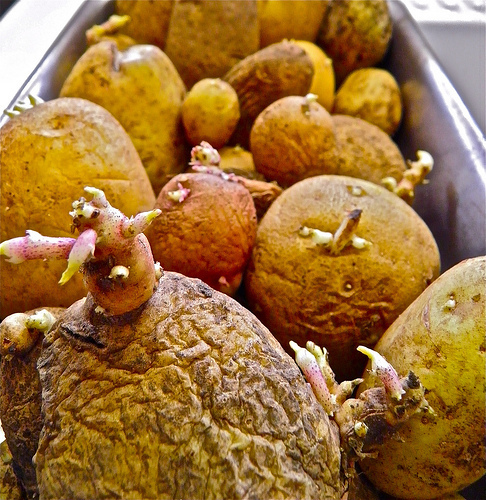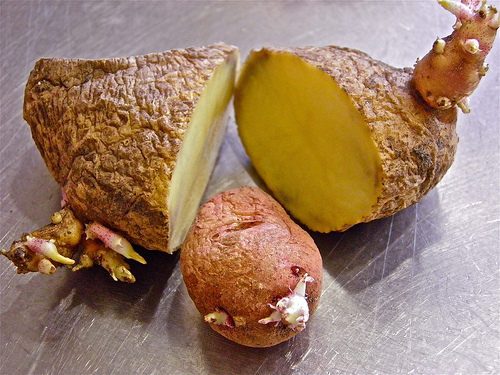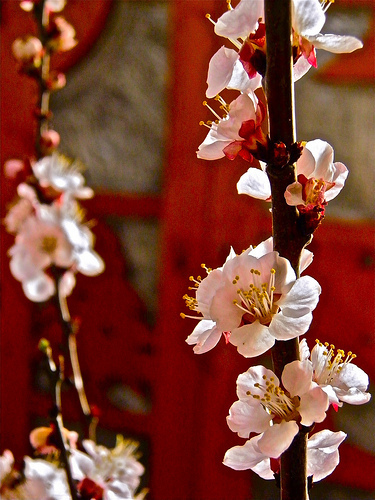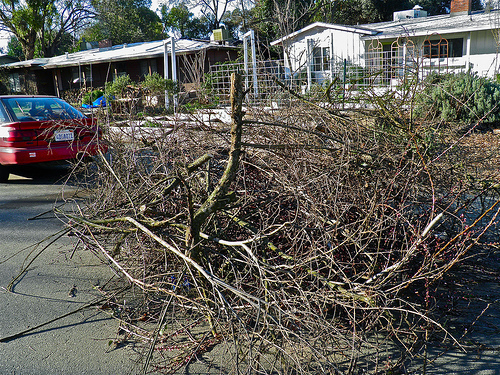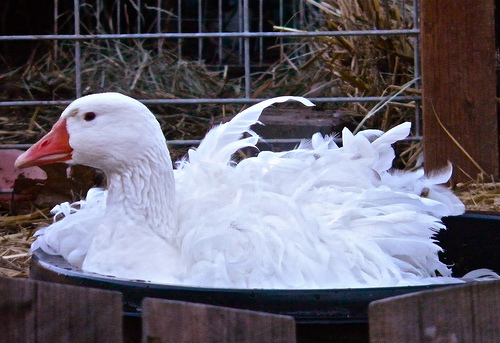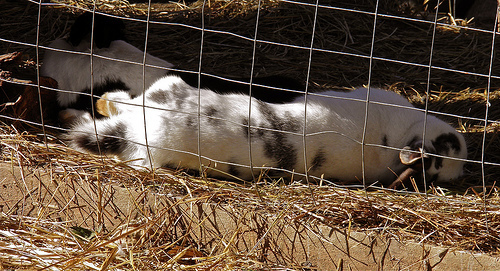Spring Warren's Blog, page 9
February 23, 2011
Why farmgirls shouldn't get their toenails painted red!
Apparently the shade is not "wicked pink" but "cherry tomato red."
Collecting eggs in my bathrobe and rubber muck sandals- Hypsipyle went after my toes and I almost threw all the eggs in the air!
February 22, 2011
QAF BOOK Give-a-way!
The Quarter Acre Farm arrived in the mail. Just like that. It is always a strange thing to get the first book after publication, after so many months…years of work, in an envelope- with no fanfare. It is like having someone jump out from behind the door and yelling, "SURPRISE!" when you rip open the nondescript manila paper and find the book, heretofore a mere IDEA, shining up at you.
More surprising is the inside of the book (after all you've seen the cover over and over by this time). The book has pages, (duh) and in my lucky case, gorgeous illustrations by Jesse "Nemo" Pruet, aka, my eldest son.
To celebrate this exciting birthing of the book, please send me the name and address of your favorite garden/food/book organization and I will send the first twenty on the list a FREE, autographed (by myself and the illustrator) copy of The Quarter Acre Farm to raffle off, to put in a silent auction, to enjoy, or even use as a doorstop if they see fit.
So give me your names, (i.e. Tour de Cluck – In support of urban coops everywhere- 1111 Feather Street, Davis, CA 95616) and I'll get the manila envelopes out in readiness!
February 18, 2011
MULCH, Beautiful FREE Mulch!
Isn't it beautiful? This pile of mulch will replenish all of the decomposed mulch that I put down in the summer. I'll put it on all the paths, between the trees in the orchard and in all the bare spots in the beds where I don't want weeds to crop up.
I am particularly pleased with this pile of mulch because the tree guys who gave it to me (yes, it was free and I'll get to that) had a nice sharp chipper that cut the limbs into fine bits. I often get mulch that is more stringy than chipped and that can be a headache to move around.
Also – isn't the color nice? It will, after some sunshine, go grey like it all does. But right now it is such a lovely terra cotta color.
Now back to the free part.
When I hear the sound of chain saws (at a time I need mulch), I write my address down on a piece of paper and get on my bike. I ride around until I find the commotion (usually a crew who is pruning branches or taking an entire tree down) then ask the foreman of the job if he would be willing to dump the chipped wood into my driveway. I give him the piece of paper with my name and address on it. This way he knows the request is premeditated and real. That sounds funny but I've heard stories from these guys about dumping mulch in a driveway and having someone come out screaming about a) they changed their mind b)didn't want THAT much or c) they didn't care that their husband/wife asked for it, to get rid of it. Imagine having to shovel all that back into a truck bed. I don't blame them for being wary.
Nine out of ten times I make the request for mulch however, it is met with great happiness. Now the crew doesn't have to take the time to go out and dump the truck's load, nor will they get hit with a charge for doing so.
And I get all that beautiful mulch. Win, win. A good day.
The spreading of the mulch won't be quite so easy, but even that is not bad with nicely chipped mulch. It clatters into the wheelbarrow like packs of cards. Light weight, almost fluffy. And it makes such a difference in the look of the yard- that in itself is most gratifying.
Besides, a little muscle put into moving mulch saves a lot of effort I'd have to put into weeding, as well as watering. It also saves nutrients which are destroyed by the sun and provides cover for insects (not all beneficial, admittedly, but enough it still goes in the pro column).
Yay, Mulch!
Mulch the Planet!
February 17, 2011
Limoncello- From Lemon to Bottle
The finished – though still mellowing – product.
I've appended the last steps to the end of this previous blog in order that all the information can be found on one entry – so if you've already read up to the point of pouring the vodka over the peels, you may want to scan to the end.
Isn't it pretty? It is, and it will make you prettier, too…at closing time, anyway, for this lemony yellow jar of stuff is actually lemon peels and VODKA. It is on my counter, even as I write this, melding together to form a beautifully tart alcoholic beverage which I will combine with a simple syrup to form a slightly sweet tart alcoholic beverage that I will serve friends in small chilled glasses on my porch on hot summer days.
Yay!
How to make it? First, I picked fruit. It was a very social limoncello making day with Sacha and Michele arriving to craft liqueurs as well, so I picked about 150 lemons. Sacha brought the vodka (did any of my neighbors see us carting bottles and bottles of it inside?) Michele brought peelers and we soon set up an assembly line.
Sacha scrubbed lemons, Michele cut the peel from the lemons, I de-pithed. Why de-pith for limoncello when I've gone on record for being very lackadaisical about de-pithing for candied peel? Because I blanch the candied peels, but not the limoncello peel and the bitterness of the pith is more likely to come through. So I pithed. This was as easy as rubbing the edge of the spoon over the inside of the peel. The soft pith came off like cotton. Those were Myer lemons, however. When we worked on the Eureka lemons the pith was not so easily encouraged to come off. It refused to come off. We labored and labored and labored over that damn pith (lots of jokes, "This is really pithing me off! hahahaha, oh we are hilarious!)
Then I picked up the peeler. Wow, that was a lot easier (only with the Eurekas). Peels went into jars, vodka went over the peels. How much? Forget measuring. Get a jar, any jar. Fill it loosely with pithed peels. Top it off with vodka.
Now let it sit. 4 days? 2 weeks? A month? Recipes vary. I let mine sit a little over 2 weeks. I dumped the vodka and peels through a colander and collected the liquid (lemony vodka) and put the peels in the compost.
Seven cups of water and four cups of sugar go into the simple syrup. I brought the mixture to a simmer, stirring to ensure the sugar was well dissolved and let it cool. I then mixed the lemony vodka with the simple sugar then decanted that mixture into clean bottles.
Beautiful. I have most of the bottles chilling in my garage, allowing them to mellow just a bit before giving them as gifts. One is in my refrigerator as we speak, calling to me with a plaintive tone, "Poooour me over ice! Into a glass rimmed in lemon sugar! With a lemon slice riding the ice cube!"
I look outside and see the dreary winter rain and wish there was some sunshine to sit and drink my limoncello in – that would be ideal. But, on the other hand, when the sun won't come out from behind the clouds, why not pour it out of a bottle?
Cheers!
February 15, 2011
The First Review of The Quarter Acre Farm is in!
Kirkus Review!
QUARTER-ACRE FARM
How I Kept the Patio, Lost the Lawn, and Fed My Family for A Year
Author: Warren , Spring
Review Date: February 15, 2011
Publisher:Seal Press
Pages: 256
Price ( Paperback ): $16.95
Publication Date: March 1, 2011
ISBN ( Paperback ): 978-1-58005-340-2
Category: Nonfiction
Classification: Gardening
The story of a farming experiment that reaped far more than fruits and vegetables.
Skepticism is the first seed planted when Warren (Turpentine, 2007), a novice gardener and self-proclaimed slacker, sought to transform her yard into a farm, in which she intended to produce 75 percent of her family's consumable food. The author readily admits, "I hate weeding. I forget to water. My garden is a testing ground for plants able to withstand abuse." This humility and honesty sets the tone for not only the project, but the book as well. Warren 's enthusiasm gained her family's gradual compliance, and each member and even a few friends contributed to the experiment in their own way. Son Sam was an enthusiast in the kitchen, his brother Jesse an avid mushroomer, and Warren's husband's patience and support cultivated not only a harvest, but family harmony as well. The author roots beneath the surface, revealing a candid account of what does and doesn't work whether in the garden, the kitchen or her life. She provides gardening tips in a witty, approachable manner, most obvious in the chapter "Sadism in the Garden." Her advice is properly seasoned with a blend of recipes that range from the simple to the downright eccentric—while trying to rid the farm of snails, a bit of culinary research confirmed her suspicion that the pests were closely related to the delicacy escargot. No matter the undertaking or the outcome, Warren demonstrates how determination and a willingness to learn can yield more than crops.
Perfect balance of tips, recipes and anecdotes for continual referencing.
February 11, 2011
Preparing Potatoes for Planting
If I were asked to identify this thing, I might be tempted to call it a sea anemone, or maybe a slug, or some spotted larval thing. The last thing I would think to call it would be appetizing. It however, should be seen this way because it is the backbone of all sorts of delicious meals. Eggs and potatoes, potato onion tart, mashed potatoes, green chile stew, vegetarian pot pie…
It is the nascent backbone of all sorts of delicious meals, actually – the sprout off a potato which will go on, if life happens to the liking of the spud, to grow into a verdant tangle of leaves above ground, and a net of tuber-producing roots below.
This is my tuber producing army – all volunteers which pitted themselves against the arctic chill of my refrigerator and still managed to shove growth from their wrinkled skins. If they want to grow that bad, I say, let 'em.
I want to get as much out of my potatoes as possible, so I cut the sprouted tubers into pieces so that each piece is no smaller than a ping pong ball AND each piece has at least one eye which is sprouting. When the tuber is cut, the inside of the potato will be glistening with moisture. I don't want to plant the potato in that condition. Just like having an open wound makes it more likely that I would end up with a bacterial infection, so it goes with potatoes. 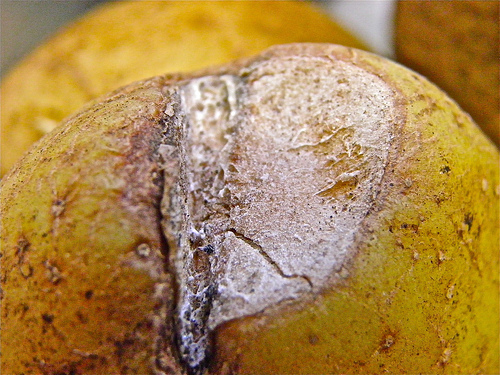
So I put them aside and let the cut surfaces heal. When the potatoes heal they make a protective surface to their wound with something called suberin. Suberin, by the way, is what cork (the same stuff in wine stoppers, on floors and bulletin boards) is largely composed of.
When all my potato seedpieces are healed over and sprouting nicely (when they have "suberized" and "chitted") then I'll plant them. I aim for sometime in February, hoping to manage to get the spuds in by March. The plants like cool-ish weather, but can't stand frost, they like springtime, but not heavy sodden soil, so there is a definite window you want to hit for the perfect potato planting time.
I look for the potatoes that I somehow missed digging up to sprout in last year's beds. When they come up, I figure it's a sign that I can put the new recruits in.
When I plant – I'll post pictures of Planting potatoes, part 2.
February 8, 2011
Springtime – blossoms, pruning, and WIND
This is the pretty by-product of spring pruning. Our apricot tree is the earliest blooming apricot I've ever seen and so it was the tree that nagged at me to get the fruit trees taken care of before the tree put its energy into growth that was only going to be discarded. I watched it form buds on its raggedy branches and even unfurl a couple of blooms before I told Louis, "That's it, I'm going out to prune and it sure would be nice if I got some help…" I was trying both to intimate it was his fault and not mine I hadn't pruned already, and, of course, to shoulder the work over to him.
The apricot was in particularly bad shape. We bought and planted our trees before we knew anything about fruit trees but for a vague dream of standing underneath green canopies, plucking apples and plums, eating them like a pack of macaques. We certainly didn't know how to prune. Because of this we pruned not at all, or pruned badly. I'm not sure which is worse. Now (thanks to R. Sanford's book "Pruning Fruit Trees" which I can't find at the moment, did I lend it to any of you?) I know each tree bears its fruit in different locations, on different ages of wood, at different weights, needing different spacing. Even trees that bear the same general kind of fruit may need wildly different treatment. The Kadota fig likes a relatively severe pruning each year, while pruning a black Mission Fig that way would prove disastrous. So it goes with so many trees..and I've gotten a bit better about the whole thing, though you might not know it looking at my poor little gnarled orchard.
Sadly my trees don't look…loved. Especially the trees around the fish pond that for the first four or five years of their lives didn't get enough sun AND we encouraged into strange shapes to keep the area shady. The trees look a bit crippled to tell the truth. We are trying to rectify that, but years of poor habit needs years to be undone. Sigh. The story of my life.
This is the not so pretty side effect of pruning. Though I have to say I feel a bit of pride at having the biggest pile of sticks on the street for once. Too, too often my neighbors have a mountain of clippings, twigs, and weeds ready for pickup, illustrating how much work they've done over the week while in front of my house…wine bottles are more likely.
This morning I woke up to high winds and was doubly glad to have gotten some of that trimming done. Better to have clipped dead limbs from the tree than have the wind rip them off. Besides, I hate being out IN the wind. It is noisy, my hair flies around occluding my vision, it's cold…
Further, the geese honked in terror every time the wind gusted ALL NIGHT LONG. Guess who woke up every time the geese were honking? Another reason to hate the wind. (Though I did end up getting up at 4 am and writing for 3 hours before any one else came into the kitchen, so there is an upside.)
Hypsipyle is recuperating from her night of wild weather by spending the day meditatively bobbing around in her pond with her feathers fluttering and ruffling about her, looking for all the world like one of those glass candy dishes in which you lift the chicken off her nest to get at the goods. Wouldn't a goose on a pool be an even better model for a candy dish? Especially a pretty goose like Hypsipyle.
February 2, 2011
Lovely lemony Limoncello!
Isn't it pretty? It is, and it will make you prettier, too…at closing time, anyway, for this lemony yellow jar of stuff is actually lemon peels and VODKA. It is on my counter, even as I write this, melding together to form a beautifully tart alcoholic beverage which I will combine with a simple syrup to form a slightly sweet tart alcoholic beverage that I will serve friends in small chilled glasses on my porch on hot summer days.
Yay!
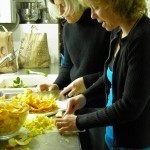

How to make it? First, I picked fruit. It was a very social limoncello making day with Sacha and Michele arriving to craft liqueurs as well, so I picked about 150 lemons. Sacha brought the vodka (did any of my neighbors see us carting bottles and bottles of it inside?) Michele brought peelers and we soon set up an assembly line.
Sacha scrubbed lemons, Michele cut the peel from the lemons, I de-pithed. Why de-pith for limoncello when I've gone on record for being very lackadaisical about de-pithing for candied peel? Because I blanch the candied peels, but not the limoncello peel and the bitterness of the pith is more likely to come through. So I pithed. This was as easy as rubbing the edge of the spoon over the inside of the peel. The soft pith came off like cotton. Those were Myer lemons, however. When we worked on the Eureka lemons the pith was not so easily encouraged to come off. It refused to come off. We labored and labored and labored over that damn pith (lots of jokes, "This is really pithing me off! hahahaha, oh we are hilarious!)
Then I picked up the peeler. Wow, that was a lot easier (only with the Eurekas). Peels went into jars, vodka went over the peels. How much? Forget measuring. Get a jar, any jar. Fill it loosely with pithed peels. Top it off with vodka.
Now let it sit. 4 days? 2 weeks? A month? Recipes vary. I'll likely let it sit until I have time to stir up some simple syrup. Then I'll add syrup to the vodka that I have removed the peel from, to taste. Bottle it and stick it in my fridge.
That would have been that but we had a couple hundred naked lemons to contend with and we three women are NOT the kind of women who would let naked lemons go to waste. We juiced and juiced. I will add some juice to some of my limoncello in an unconventional limoncello-making move. (report to follow) Sacha might make jelly – Michele has already turned hers into lemon curd. I know because there was a jar of it on my porch this morning when I came back from my run. Who else has ways of using lemon juice?
Let us know – there are more lemons on the tree!
January 30, 2011
Kwantu!!!!
No, no…don't panic. She's not dead, though that is just what I thought when I looked over from where I was working on the NE corner of the farm. I almost had a heart attack, and then would have looked just like that, but with less fancy clothes on. I shouted, "Kwantu?" and every animal on the place cackled, honked, jumped, yowled, or, in Kwantu's case, raised their sleepy head upward, then seeing I wasn't bringing something nice over, went back to their nap.
It was sunny, that's the thing. And what feels better after days and days and days of cold, rainy grey skies, than to recline in a pool of sunshine and dream of such days ahead, every day…yes, summertime.
I could've joined her, but as a farmer (albeit a quarteracre farmer) I have to take every sunny day opportunity to work. Move the beds, configure a new area for the potatoes to be planted in (Next month is coming up in just a day!) spread mulch, and weed.
I am trying to keep atop the weeding this year, pulling the dontwanttheres while the ground is soft and before the plants are knee high. It is a lot more pleasant to weed if I think of it as bringing treats to the geese. They LOVE fresh grass, adore thistle leaves and dandelion greens… and there's always more to eradicate.
And then…a nice nap in the sun.
January 25, 2011
A FIVE STAR RESTAURANT!
I spent some time this last weekend with Stella Ruiz, the founder and mad genius of The Five Star Restaurant at Oak Ridge, a program that takes fourth graders and transforms them into restauranteurs. We had the first meeting of this fabulous group, that includes the chef from Nugget Markets, Jeff Clark and volunteers from many arenas including Banking, Human Relations, the Courts, Police Offices – but most importantly the super fourth graders from Oak Ridge Elementary in Sacramento.
On the very first day students jumped right in, learning the art of cooking. On the menu was a soup medley – chicken barley and butternut squash – garlic bread, followed up with brownies. This was no exercise in opening cans and re-heating, nor breaking open a box and reconstituting pre-configured mixes. Instead students scooped seeds from squash, chopped onions, minced garlic, broke eggs – and the results were delicious.
We all know that running a successful restaurant is not just about cooking, however. The kids at Oak Ridge filled out job applications and went through interviews to get jobs in Customer Relations, Accounting, Media Production, Sales, Interior Design, Financial Management, and Service.
Writing skills never hurt either. That's where I came in. Students started journals as well. They did a phenomenal job. Saturday morning – kids working hard. One of the Principles of The Five Star Restaurant (along with WE CARE DEEPLY ABOUT OUR EARTH, OUR FOOD, AND EACH OTHER) is THERE IS NO ROOM IN OUR BUSINESS FOR WHIMPS, WHINERS, AND SLACKERS. I didn't see nary a one there. Pretty impressive.
How will these kids fare as they make their restaurant a reality? Updates to follow.

